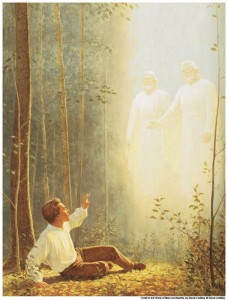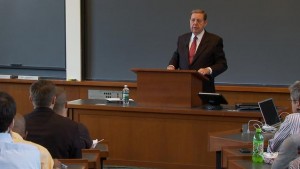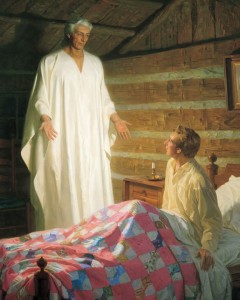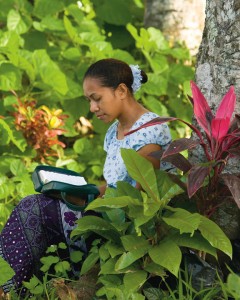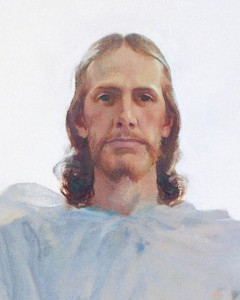The Mormon Apostle Jeffrey R. Holland spoke on March 20, 2012 to students of the Harvard University Law School as part of the school’s annual “Mormonism 101” series. Elder Holland (Mormon leaders are traditionally addressed by the title, “Elder”) explained about the history and beliefs of The Church of Jesus Christ of Latter-day Saints, whose members are often called “Mormons.” He then engaged in a question-and-answer session with members of the audience. Elder Holland’s remarks helped shed some light on the Church, which has received a lot of media attention lately due to the presidential candidacy of Mitt Romney.
Elder Holland began his remarks by congratulating the students on their openness to discussions of religious belief. “In the western world religion has historically been the basis of civil society as we have known it, and if I am not mistaken, men and women of the law are committed to the best—that is, the most just—civil society possible,” Elder Holland pointed out. “So thank you for taking religion seriously. You will not only be better attorneys but you will be closer to the truth in your own personal lives.”
Mormonism: The Restored Gospel of Jesus Christ
The origins of Mormonism were the first topic addresses by Elder Holland. Mormonism is a restoration of the original gospel established by Jesus Christ during his earthly ministry. Following Christ’s ascension into heaven and the deaths of the original twelve apostles, the primitive Christian Church entered a long period of confusion:
So what ensued was a millennium and a half of destroying Paul’s hope that there would be a “unity of the faith, and [a] knowledge of the Son of God, . . . that we henceforth be no more children, tossed to and fro, and carried about with every wind of doctrine, by the sleight of men, and cunning craftiness, whereby they lie in wait to deceive.” It is commonplace to note that in the Christian world we now see anything but “a unity of faith” or any real Christian cohesiveness that could remotely be called “the building fitly framed together”that would reaffirm “one Lord, one faith, one baptism.”
The Mormon Prophet, Joseph Smith
By the time of Joseph Smith, who was a young man during the time of religious contention and revival during the early 1800s in the United States known as the second “Great Awakening,” huge divides of doctrine separated the different Christian sects from one another. According to Elder Holland,
This young boy-prophet lamented that his region was “a scene of great confusion and bad feeling . . . priest contending against priest, and convert against convert; so that [any] good feelings . . . were entirely lost in a . . . war of words and tumult of opinions.” “A war of words and tumult of opinions.” That says so much about post-New Testament Christianity.
- Every man, woman, and child who has ever lived, now lives, or will yet live so long as the earth shall last is a son or daughter of a loving and divine Heavenly Father.
- In order to gain a mortal body and experience moral growth available in no other way, a real Adam and a real Eve chose to leave a paradisiacal setting—Eden, if you will—to learn all that was necessary for children of God to learn.
- Because mistakes would be made in the course of that mortal education—sometimes horrible mistakes, wrenching mistakes, global mistakes—a Savior was provided in such a plan, one who would atone not only for Adam and Eve’s initial transgression…but also for every individual transgression made by all…the sins and sorrows, the disappointments and despair, the tears and tragedies of every man, woman, and child who would ever live from Adam to the end of the world.
- Such a plan was necessary and such a Savior was required in it because life is eternal. Our hopes and dreams mattered before we came to this earth, and they will most certainly matter after we leave it.
- Lastly, this plan, this divine course outlined for us—including the fortunate Fall in Eden and the redemption of Gethsemane and Calvary—is universally inclusive. All are children of the same God, and all are included in His love and His grace.
We are not fourth-century Christians, we are not Nicene Christians, we are not creedal Christians of the brand that arose hundreds of years after Christ. No, when we speak of “restored Christianity” we speak of the Church as it was in its New Testament purity, not as it became when great councils were called to debate and anguish over what it was they really believed. So if one means Greek-influenced, council-convening, philosophy-flavored Christianity of post-apostolic times, we are not that kind of Christian. Peter we know, and Paul we know, but Constantine and Athanasius, Athens and Alexandria we do not know. (Actually, we know them, we just don’t follow them.)
Doctrinal Differences Between Mormons and More Recent Christianity
A few doctrinal differences between Mormon doctrines and post-fourth-century traditions were pointed out:
- God the Father and His Son, Jesus Christ, are separate and distinct beings with glorified bodies of flesh and bone. As such, we stand with the historical position that “the formal doctrine of the Trinity as it was defined by the great church councils of the fourth and fifth centuries is not to be found in the [New Testament].”…However, having affirmed the point of Their separate and distinct physical nature, we declare unequivocally that [God the Father and His Son, Jesus Christ] were indeed “one” in every other conceivable way—in mind and deed, in will and wish and hope, in faith and purpose and intent and love. They are most assuredly much more alike than They are different in all the ways I have just said, but They are separate and distinct beings as all fathers and sons are. In this matter we differ from traditional creedal Christianity but agree with the New Testament.
- We also differ with fourth and fifth century Christianity by declaring that the scriptural canon is not closed, that the heavens are open with revelatory experience, and that God meant what He said when He promised Moses, “My works are without end, and . . . my words . . . never cease.” We believe that God loves all His children and that He would never leave them for long without the instrumentality of prophets and apostles, authorized agents of His guidance and direction.
- …we are unique in the modern Christian world regarding one matter which a prophet and president of The Church of Jesus Christ of Latter-day Saints called our “most distinguishing feature.” That is, divine priesthood authority to provide the saving sacraments—the ordinances—of the gospel of Jesus Christ. The holy priesthood, which has been restored to the earth by those who held it anciently, signals the return of divine authorization. It is different from all other man-made powers and authorities on the face of the earth. Without it there could be a church in name only, and it would be a church lacking in authority to administer in the things of God. This restoration of priesthood authority eases centuries of anguish among those who knew certain ordinances and sacraments were essential but lived with the doubt as to who had the right to administer them. In The Church of Jesus Christ of Latter-day Saints we can answer the question of “who laid hands on him” all the way back to Christ Himself. The return of such authority is truly “the most distinguishing feature” of our faith.

